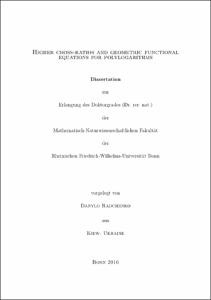Radchenko, Danylo: Higher cross-ratios and geometric functional equations for polylogarithms. - Bonn, 2016. - Dissertation, Rheinische Friedrich-Wilhelms-Universität Bonn.
Online-Ausgabe in bonndoc: https://nbn-resolving.org/urn:nbn:de:hbz:5n-44595
Online-Ausgabe in bonndoc: https://nbn-resolving.org/urn:nbn:de:hbz:5n-44595
@phdthesis{handle:20.500.11811/6872,
urn: https://nbn-resolving.org/urn:nbn:de:hbz:5n-44595,
author = {{Danylo Radchenko}},
title = {Higher cross-ratios and geometric functional equations for polylogarithms},
school = {Rheinische Friedrich-Wilhelms-Universität Bonn},
year = 2016,
month = aug,
note = {In this work we define and study a generalization of the classical cross-ratio. Roughly speaking, a generalized cross-ratio is a function of n points in a projective space that is invariant under the change of coordinates and satisfies an arithmetic condition somewhat similar to the Plücker relation. Our main motivation behind this generalization is an application to the theory of polylogarithms and a potential application to a long-standing problem in algebraic number theory, Zagier's conjecture.
We study S-unit equations of Erdös-Stewart-Tijdeman type in rational function elds. This is the equation x + y = 1, with the restriction that x and y belong to some two fixed multiplicative groups of rational functions. We present an algorithm that enumerates solutions of such equations. Then we study the way in which the solutions change if we fix the multiplicative group of one of the summands and vary the multiplicative group of the other. It turns out that there is a maximal set of "interesting" solutions which is finite and depends only on the first multiplicative group, we call such solutions exceptional.
Next, we study the properties of the algebra of SLd-invariant polynomial functions on n-tuples of points in d-dimensional vector space. The general definition of S-cross-ratios and exceptional S-cross-ratios is then given. After that, we look at the problem of classifying exceptional S-cross-ratios in the special case when S is the set of all d x d minors. We give such classification for small values of n, d and then, based on these calculations, give a general conjectural description.
Chapter 4 is devoted to the review of the classical and single-valued polylogarithms and the conjecture of Zagier about special values of Dedekind zeta functions. We then outline Goncharov's strategy for proving Zagier's conjecture. It is this strategy that serves as our main motivation for the study of exceptional cross-ratios.
In the last chapter we apply the results about S-unit equations to the theory of polylogarithms by proving a finiteness result for the space of nontrivial functional equations. By making use of exceptional cross-ratios that were computed in Chapter 3, we construct many symmetric functional equations for polylogarithms. We conclude by discussing the prospect of using these functional equations for proving Zagier's conjecture in the next open case.},
url = {https://hdl.handle.net/20.500.11811/6872}
}
urn: https://nbn-resolving.org/urn:nbn:de:hbz:5n-44595,
author = {{Danylo Radchenko}},
title = {Higher cross-ratios and geometric functional equations for polylogarithms},
school = {Rheinische Friedrich-Wilhelms-Universität Bonn},
year = 2016,
month = aug,
note = {In this work we define and study a generalization of the classical cross-ratio. Roughly speaking, a generalized cross-ratio is a function of n points in a projective space that is invariant under the change of coordinates and satisfies an arithmetic condition somewhat similar to the Plücker relation. Our main motivation behind this generalization is an application to the theory of polylogarithms and a potential application to a long-standing problem in algebraic number theory, Zagier's conjecture.
We study S-unit equations of Erdös-Stewart-Tijdeman type in rational function elds. This is the equation x + y = 1, with the restriction that x and y belong to some two fixed multiplicative groups of rational functions. We present an algorithm that enumerates solutions of such equations. Then we study the way in which the solutions change if we fix the multiplicative group of one of the summands and vary the multiplicative group of the other. It turns out that there is a maximal set of "interesting" solutions which is finite and depends only on the first multiplicative group, we call such solutions exceptional.
Next, we study the properties of the algebra of SLd-invariant polynomial functions on n-tuples of points in d-dimensional vector space. The general definition of S-cross-ratios and exceptional S-cross-ratios is then given. After that, we look at the problem of classifying exceptional S-cross-ratios in the special case when S is the set of all d x d minors. We give such classification for small values of n, d and then, based on these calculations, give a general conjectural description.
Chapter 4 is devoted to the review of the classical and single-valued polylogarithms and the conjecture of Zagier about special values of Dedekind zeta functions. We then outline Goncharov's strategy for proving Zagier's conjecture. It is this strategy that serves as our main motivation for the study of exceptional cross-ratios.
In the last chapter we apply the results about S-unit equations to the theory of polylogarithms by proving a finiteness result for the space of nontrivial functional equations. By making use of exceptional cross-ratios that were computed in Chapter 3, we construct many symmetric functional equations for polylogarithms. We conclude by discussing the prospect of using these functional equations for proving Zagier's conjecture in the next open case.},
url = {https://hdl.handle.net/20.500.11811/6872}
}






